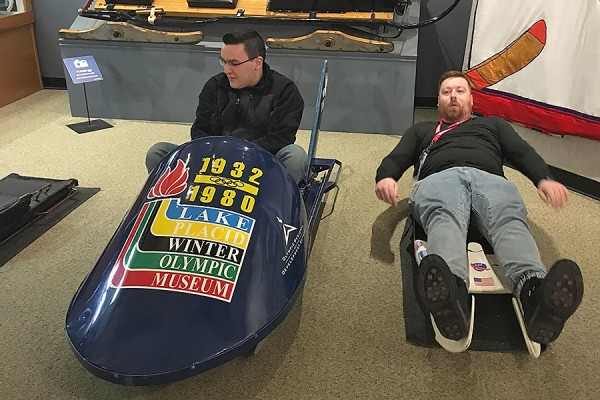 Sport management students Bryan Dutot and Zachary Evans test out the exhibits at the Lake Placid Olympic Museum.
Sport management students Bryan Dutot and Zachary Evans test out the exhibits at the Lake Placid Olympic Museum.
Nine UWindsor sport management graduate students gained networking opportunities, education, and golden memories they will never forget on a field trip to historic sites last weekend.
Professor Scott Martyn took students in his “Crises, Politics and Commercialism in the Modern Olympic Movement” class on a five-day Olympic journey to Toronto, Montreal, and Lake Placid, New York.
This annual trip provides students with an opportunity to experience first-hand the modern Olympic movement, network with professionals in the field of sport management, develop contacts for the future, and observe the practical side of classroom learning.
During the trip, the group visited the Canadian Olympic Committee (COC) offices in Toronto and Montreal where Sandra Sassine, program administrator of education for the COC in Montreal, offered some advice for the students: “Know yourself, know what your limits are and how hard you can push yourself.”
Attendee Kim Lemon said she appreciated the tip.
“I know that Sandra’s advice will help when I am going on interviews,” she said. “She was extremely informative and helpful in answering questions and giving advice.”
Following the tour of the Canadian Olympic Committee office, the group ventured to the World Anti-Doping Agency where they were met by Michèle Mercier, manager of relations with national and regional anti-doping organizations. She delivered an informative presentation and led the group on a tour of the office.
The last stop on the journey was Lake Placid, site of the 1932 and 1980 Winter Olympic Games. Students stayed at the United States Olympic Training Center, where Olympians also live and train to prepare for the Games.
The city is the only Olympic host city where each of the venues is in sight of the others.
To top it off, the students toured Herb Brooks Arena, home of the 1980 Miracle on Ice, and watched a university hockey game that evening.
Student Maggie Veitch said the learning experience helped her to apply knowledge she gained in the classroom.
“We have spent a great deal of time in class studying doping and the evolution of the Olympics,” she said. “However, it is not until you visit first-hand the World Anti-Doping Agency and the sites of the 1932, 1976, and 1980 Olympics that you can truly understand the modern Olympic movement.”
Her classmate Giulia Barile says the trip also provided an opportunity to bond with fellow students.
“It was awesome to get to know everyone better and now have those tight-knit friendships within our program,” Barile said. “I now know that these people will be my friends for life.”
